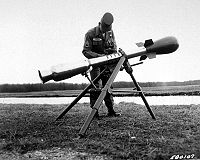Davy Crockett (nuclear device)
From Wikipedia, the free encyclopedia
The M-388 Davy Crockett was a tactical nuclear recoilless rifle projectile that was deployed by the United States during the Cold War. It was named after American soldier, Congressman and folk hero Davy Crockett (1786-1836).
Contents |
[edit] Development
One of the smallest nuclear weapons ever built, the Davy Crockett was developed in the late 1950s for use against Soviet troops had war broken out in Europe. Small teams of the Atomic Battle Group (charged with operating the device) would be stationed every few kilometers to guard against Soviet attack, using the power of their nuclear artillery to kill or incapacitate advancing troop formations and irradiate the area so that it was uninhabitable for up to 48 hours, long enough to mobilize NATO forces.
The M-388 round used a version of the W54 warhead, a very small sub-kiloton fission device. The Mk-54 weighed about 51 lb (23 kg), with a selectable yield of 10 or 20 tons (very close to the minimum practical size and yield for a fission warhead) up to 0.5 kiloton. The complete round weighed 76 lb (34.5 kg). It was 31 in. (78.7 cm) long with a diameter of 11 in. (28 cm) at its widest point; a subcaliber piston at the back of the shell was actually inserted into the launcher's barrel for firing. [1]
The Davy Crockett could be launched from either of two launchers: the 4-inch (102 mm) M28, with a range of about 1.25 mi (2 km), or the 6-in (155 mm) M29, with a range of 2.5 mi (4 km). Both weapons used the same projectile, and could be mounted on a tripod launcher or carried by truck or armored personnel carrier. They were operated by a three-man crew. [2]

Both recoilless guns proved to have poor accuracy in testing, so the shell's greatest effect would have been its extreme radiation hazard. Even at a low yield setting, the M388 would produce an almost instantly lethal radiation dosage (in excess of 10,000 rem) within 500 feet (150 m), and a probably fatal dose (around 600 rem) within a quarter mile (400 m). [3]
The warhead was tested on July 7, 1962 in the Little Feller II weapons effects test shot, and again in an actual firing of the Davy Crockett from distance of 1.7 miles (2.72 km) in the Little Feller I test shot on July 17. This was the last atmospheric test detonation at the Nevada Test Site.
Production of the Davy Crockett began in 1956, with a total of 2,100 being made. The weapon was deployed with U.S. Army forces from 1961 to 1971.
Versions of the W54 warhead were also used in the Special Atomic Demolition Munition project and the AIM-26A Falcon.
[edit] Survivors
| This section requires expansion. |
Below is a list of museums which have a Davy Crockett casing in their collection:
- Air Force Space & Missile Museum, Cape Canaveral Air Force Station, Florida
- National Atomic Museum, Albuquerque, New Mexico
- National Infantry Museum, Fort Benning, Georgia
- United States Army Ordnance Museum, Aberdeen Proving Ground, Maryland
- Watervliet Arsenal Museum, Watervliet, New York
- West Point Museum, West Point, New York
- Atomic Testing Museum, Las Vegas, Nevada
[edit] See also
[edit] References
- ^ Characteristics of all US nuclear weapons designs, accessed October 20, 2006
- ^ Guntruck.com Davy Crockett page, accessed Oct 20, 2006
- ^ Nuclear Weapons FAQ Section 5.6, Mechanisms of Damage and Injury, accessed October 20, 2006
[edit] External links
- Facts about the "Davy Crockett" missile
- Characteristics of all US nuclear weapons designs
- Davy Crocketts in Southern Avenue of Fulda Gap
- Davy Crocketts during Oct 62 Cuban Crisis (Southern Avenue of Fulda Gap)
- Source of some of the information
- Video showing testing of device on youtube.com
- Operation Ivy Flats — testing of the Davy Crockett, 1962 (17:46)
- Wee Gwen - a UK weapon similar to Davy Crockett



